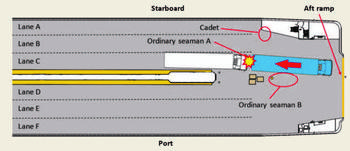202431 Limited experience + limited communication = bad consequence
As edited from SHK (Sweden) report 2023:11e
A ferry was in port loading cars and trucks. Communication between the drivers and the crew members during loading took place visually through hand signals and via hearing with whistles. The crew who were loading wore yellow high-visibility clothing equipped with reflectors, and the deck apprentice, who was not participating in loading, wore an orange vest that was marked ‘Cadet’.
One semi-trailer truck had already been parked in lane C and another one was being directed to reverse in the same lane by crew member B, parking in front of the first truck. As this was happening, crew member A stepped in front of the first parked truck to retrieve an electrical cable. He then realised the second truck was reversing towards him, and tried to escape his precarious position but was trapped.
The reversing truck driver felt resistance and stopped the truck. The previously parked truck driver saw the impending accident unfold so he quickly reversed. Crew member A was slightly crushed but due to the quick actions of both truck drivers was spared serious injuries. Once the ambulance arrived, the victim was examined and then taken to hospital for further investigations and observation for three days.
Safety mitigation measures had been implemented following an earlier company risk assessment related to accidents while loading, These included wearing reflective overalls, yellow reflective gloves and using a whistle as a stop signal. Other measures documented were that the person directing traffic was to stand where they are visible to the driver and not directly behind reversing vehicles.
Among other things, the investigation found that crew member A had not conducted loading towards the aft ramp in lane C before. Neither of the crew members on duty had previously been responsible for reversing vehicles. As it was, they were tasked with duties with which they did not have previous experience but were expected to perform safely nonetheless.

Lessons learned
- While wearing high visibility PPE is certainly a needed precaution for crew loading a ferry, this precaution does not solve everything. Good judgement and common sense are also needed.
- Good communication is a key component of safety. In this case the crew member directing the truck was not in contact with the victim.
- The victim’s actions are an example of single-minded attention to one task; he wanted to retrieve the electrical cable. But, without first examining his environment, he walked into a dangerous situation.
Always keep your situational awareness sharp! - A preferred practice is to mix an experienced crew with a less experienced crew member in order to reduce the chances of inexperience causing a negative outcome.
